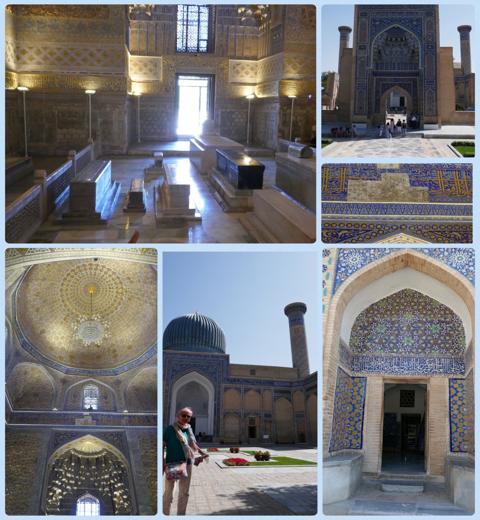Central Asia - Uzbekistan -Samarkand - Part 2

Continuing on our tour of Samarkand our next marvel was visiting Gur-e-Amir Mausoleum, where Ulugh Beg is buried with his brother, his grandfather Amir Timur, and Timur’s two sons. The intricate tilework yet again simply stunning, inspiring many architects, including Ustad-Ahmad Lahori who built the Taj Mahal in India!
Amir Timur never expected to be buried here; he had already built himself a crypt in his hometown of Shakhrisabz and had Gur-e-Amir built in 1404 for one of his grandsons. However, in 1405, Timur died unexpectedly of pneumonia in Kazakhstan. Because it was winter, the road back to Shakhrisabz was blocked by snow, so he was buried here instead.
We admired the facade, courtyard, stunning golden dome and interior of the mausoleum, the tile work - mostly restored, with one section left to show pre-restoration. When the cupola is ribbed it always indicates a connection with Timur.

We also visited the Shah-i-Zinda complex - an avenue flanked by magnificent temples and mausoleums, housing the remains of famous and unknown people.
All built at various times between the 11th and 19th centuries, this sacred necropolis showcases some of the richest tile work in the Muslim world.






Amidst controversy the complex was restored in 2005 and much of the mosaic tilework is not original, but I’m sure most people would prefer to see a considerate preservation of the intricate workmanship, tile designs and patterns, as they would have been in bygone days.
The site is cloaked in mystery related to the name of the complex - Shah-i-Zinda translates to The Living King.
The Prophet Muhammad's uncle, Kussama ibn Abbas is said to have brought Islam to this region in the 7th century. During a battle with heathens Kussama Ibn Abbas was mortally wounded. Some legends say he was beheaded, others say it was a wound by an arrow.
They all agree though, the spirit of the Saint Hazrat Hyzr came down to the mortally wounded Kussama ibn Abbas and helped him escape from the battlefield and placed him in the well of Shaaban, where having drunk the water of life, recovered and became immortal.

Bibi-Khanym Mosque is one of the biggest mosques in the Islamic world. Completed in 1404, it was the jewel of the Timurid Empire and could hold up to 10,000 worshippers.
It was built by architects from India and Iran, with the help of 95 elephants hauling construction material, but reduced to ruins by the earthquake of 1897 - reconstruction began in the 1970s under the Soviets.
After the fall of the USSR, Islam Karimov (Uzbekistan’s first president) put a lot of effort into restoring Timurid-era monuments, and much of the mosque was quickly rebuilt.

In the 14th century, Amir Timur’s wife ordered the building of this mosque as a gift for him on his return from India. The architect fell in love with her and constantly delayed construction. To speed it along, he told her she must plant a kiss on his cheek.
After some hesitation, she did, and Timur was welcomed home to the beautifully completed Bibi-Khanym Mosque. It is said the kiss left a mark on her cheek, Timur was so enraged he ordered the architect’s death and buried him underneath a mausoleum. Furthermore he ordered all women to cover their faces from then on - is it true or another fascinating legend?
Our guide Guyla stands in front of the large marble Quran lecturn donated by Ulug Beg, which once held the 1 metre square Osman Koran and we saw in Tashkent.
Legend (yes another one!) promises children to barren women, who crawl three times between the lectern's nine legs. This isn’t possible today, as UNESCO donated funds to encase the stand in a protective glass cabinet.
As we meandered about the site, locals were keen to have their photos taken. I took theirs as well, hard to make them understand I wanted one with all of us.
It was time for some fun at the bazaar! Siyob Bazaar, one of the largest in Uzbekistan, dates back to the 14th century, one of the first major centres of trade during the Timurid Empire.

Merchants from Central Asia and beyond would trade their products here, interact with different cultures, and engage in economic and cultural trade.
The hustle and bustle of bazaar though provided a sense of those bygone days – I loved the hive of activity as traders bartered to sell their wares, while women queued to buy their bread, known as non. Samarkand bread is sort after across the country, famous for its taste and stays fresh for a long time - edible for up to 3 years, by sprinkling with water and heating in an oven.
Some of the bread we tried at our dinners, seemed to be 3 years old it was so hard, but the bread Gulya bought for us at the market was very good.

We had a chance to wander along part of the old Silk Road - not that we could tell, however a camel mural, yurt and yet another fine mausoleum, which lead to the bazaar, provided a few hints.
The extravagance of the buildings in Samarkand was overwhelming - even the restaurants are opulent.
It was time to leave stunning Samarkand and travel along more of the Silk Road to Bukhara, where we enjoyed some stops along the way, which I will share on the next post of my travels through Central Asia.
